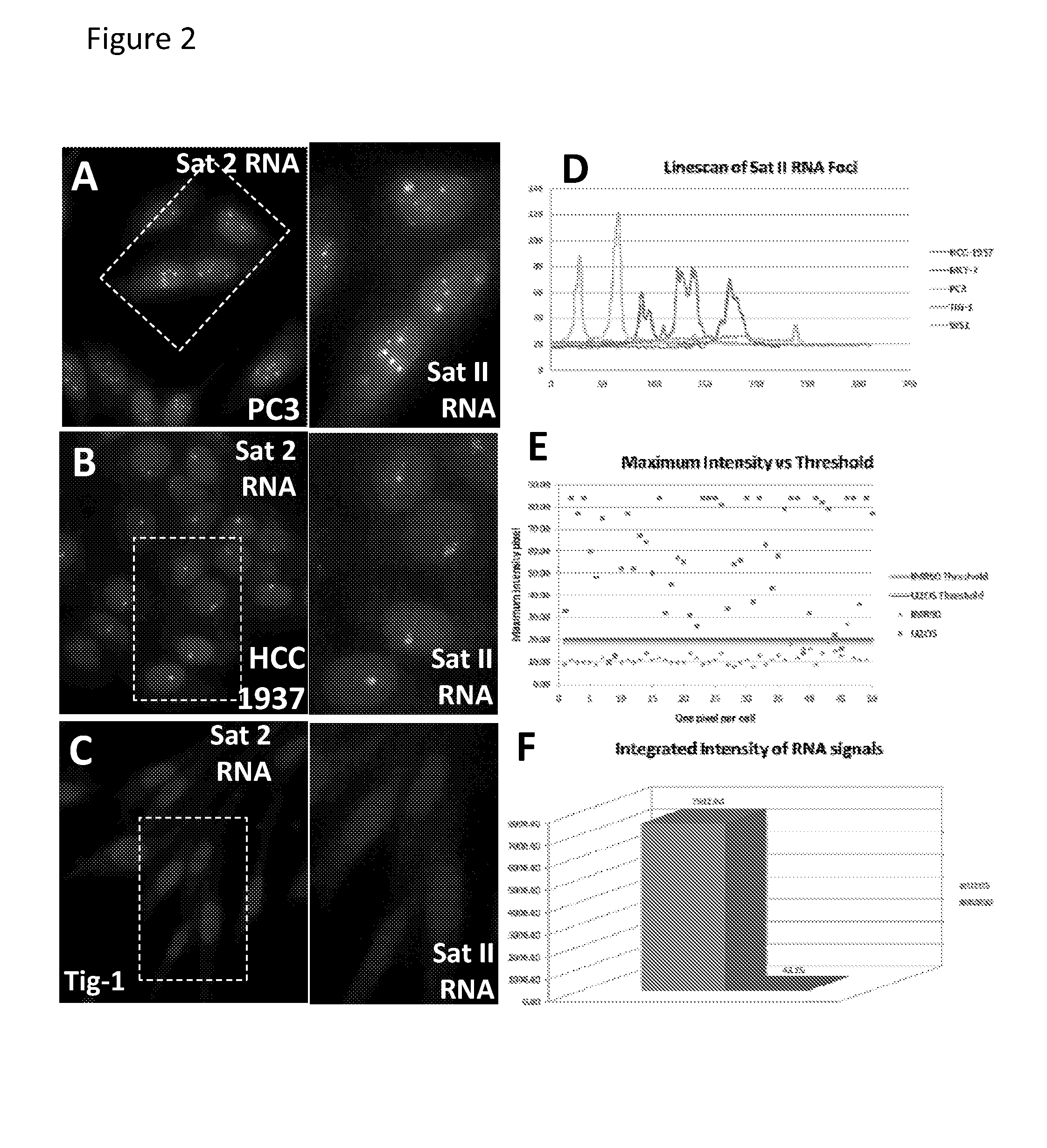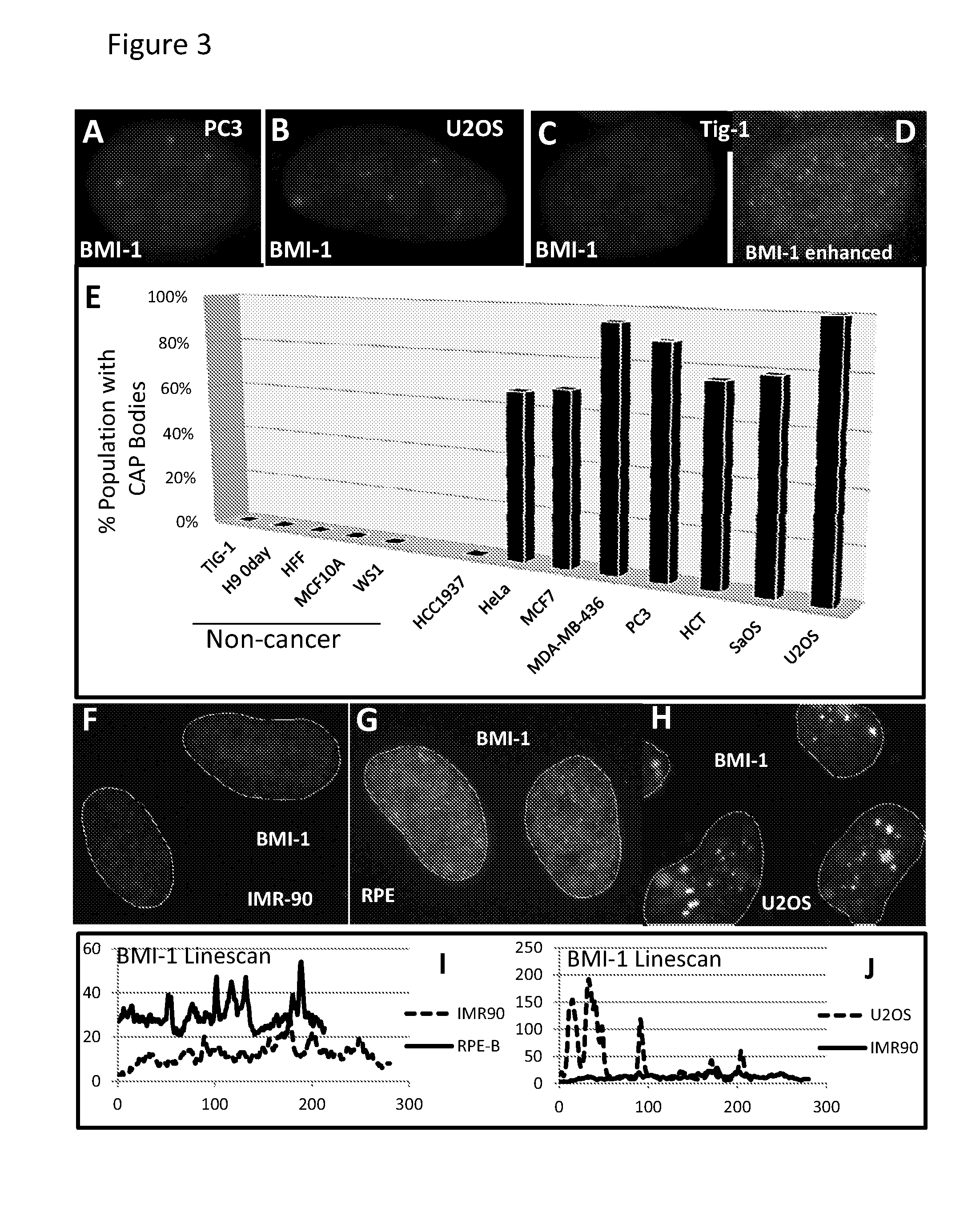Methods of diagnosing cancer using epigenetic biomarkers
a biomarker and epigenetic technology, applied in the field of methods of diagnosing cancer using epigenetic biomarkers, can solve the problems of complex role, unresolved, and inability to discover repeat expression aberrations, and achieve the effect of easy quantification and easy differentiation of cancer cells
- Summary
- Abstract
- Description
- Claims
- Application Information
AI Technical Summary
Benefits of technology
Problems solved by technology
Method used
Image
Examples
example 1
Satellite II DNA and Abnormal Nuclear Accumulations of Sat II RNA Mediate Failed Compartmentalization of Master Epigenetic Regulators BMI-1 and MeCP2
Summary
[0079]Epigenomic changes in cancer involve paradoxical gains and losses of heterochromatin within the same nucleus. We report that failed nuclear compartmentalization of polycomb proteins, master regulators of heterochromatin, is prevalent in cancer, and links to locus-specific over-expression of human Satellite II. In cancer, BMI-1 and Ring 1B aggregate in prominent Cancer-Associated PcG (CAP) bodies on the large ˜6 Mb locus at 1q12, which remains silent. In the nucleoplasm low in BMI-1, other Sat II loci express abundant RNA foci; these repeat RNAs accumulate methyl-cytosine binding protein, forming Cancer-Associated Satellite Transcript (CAST) bodies (previously referred to in U.S. 61 / 507,937 as Cancer-Associated MeCP2 (CAM) bodies). BMI-1 body formation on 1q12, a region commonly hypomethylated in cancer, is induced in normal...
example 2
Over-Expression of Satellite II RNA and Failed Nuclear Compartmentalization of Polycomb Proteins is Common in Human Breast Cancers and Provides a Sensitive Biomarker of Epigenetic Instability, Potentially Linked to Tumor Type, Stage or Aggressiveness
[0187]Human Pericentromeric Satellite II Repeats are Aberrantly and Grossly Expressed in Cancer:
[0188]Almost 50% of the human genome consists of repetitive sequence elements with high-copy tandem satellite repeats associated with centromeric regions, such as Satellite II, representing a major portion of the repeat fraction. While alpha-satellite (α-Sat) is at the centromere proper of all human chromosomes, Satellite II (Sat II) defines the pericentromere of several chromosomes, the largest (˜6 Mb) on Chr 1q12 and also Chr 16, and smaller Sat II on several other chromosomes. Sat II is comprised of thousands of ˜25 bp repeats, evolved from the 5 bp more conserved Sat III repeat on Chr. 9 (Richard et al. 2008). While long thought to be sile...
example 3
DNA Hybridization with a Probe to the 1q12 Satellite II Locus to Assay for Aberrant Increase in Representation of this 1q12 Satellite in Cancer
[0231]All normal human cells have just two copies of the largest (6 Mb) satellite II locus on Chr 1q12, one on each of the two homologous chromosomes (illustrated in Example 1, FIG. 4A and FIG. 6D). Prior to our findings, this satellite II locus had no known function in normal cells or disease, but our findings show that it is the 1q12 satellite specifically that is involved in the mis-compartmentalization of polycomb proteins in cancer.
[0232]As shown in FIG. 4B (discussed in more detail in Example 1 above), cancer cells may be characterized by the presence of an increased number of this 1q12 satellite locus. Fluorescence in situ hybridization to cellular DNA using a cloned probe (puc 1.77 DNA) that specifically detects the 1q12 satellite locus clearly shows that in the nucleus of this U20S osteosarcoma cell there are three 1q12 satellite loc...
PUM
| Property | Measurement | Unit |
|---|---|---|
| Tm | aaaaa | aaaaa |
| pH | aaaaa | aaaaa |
| pH | aaaaa | aaaaa |
Abstract
Description
Claims
Application Information
 Login to View More
Login to View More - R&D
- Intellectual Property
- Life Sciences
- Materials
- Tech Scout
- Unparalleled Data Quality
- Higher Quality Content
- 60% Fewer Hallucinations
Browse by: Latest US Patents, China's latest patents, Technical Efficacy Thesaurus, Application Domain, Technology Topic, Popular Technical Reports.
© 2025 PatSnap. All rights reserved.Legal|Privacy policy|Modern Slavery Act Transparency Statement|Sitemap|About US| Contact US: help@patsnap.com



